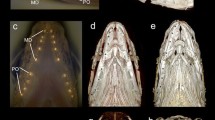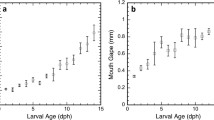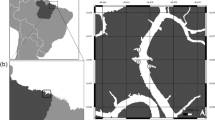Abstract
Fish that feed on individual zooplankton usually exhibit strong selectivity for large prey. Such selectivity can result from the predator’s active choice of larger prey or from differential encounter rate due to lower detectability of small prey, or both. In diurnal fishes, selectivity is thought to be determined mostly by active choice. In spite of a lack of direct observations, active choice is also considered the prevailing mechanism of prey selectivity in nocturnal fishes. Our objective was to resolve this mechanism in the highly selective, nocturnal zooplanktivorous fish Apogon annularis. Laboratory experiments indicated that the fish’s encounter rate with small prey was lower than that with large prey and that its selectivity became stronger with decreasing light intensity. Feeding efficiency, defined as the ratio between feeding and encounter rates, ranged 41–89% and was positively correlated with prey size. When feeding on a mixture of prey sizes, the fish fed on each size group at a rate similar to that of its feeding on the respective size alone, indicating that selectivity in A. annularis was due to size-dependent encounter rate and differential feeding efficiency. A low visual acuity in A. annularis, as inferred from its inability to detect small prey (<0.9 mm in length), together with the low abundance of large zooplankton in situ, can explain the dominance of differential encounter over active choice in this nocturnal coral-reef fish.





Similar content being viewed by others
References
Aksnes DL, Utne ACW (1997) A revised model of visual range in fish. Sarsia 82:137–147
Bollens SM, Frost BW, Lin TS (1992) Recruitment, growth and diel vertical migration of Euphausia pacifica in a temperate fjord. Mar Biol 114:219–228
Charnov EL (1976) Optimal foraging, the marginal value theorem. Theor Popul Biol 9:129–136
Chesson J (1983) The estimation and analysis of preference and its relationship to foraging models. Ecology 64:1297–1304
De Robertis A, Ryer CH, Veloza A, Brodeur RD (2003) Differential effects of turbidity on prey consumption of piscivorous and planktivorous fish. Can J Fish Aquat Sci 60:1517–1526
Eggers DM (1977) The nature of prey selection by planktivorous fish. Ecology 58:46–59
Gardner MB (1981) Mechanisms of size selectivity by planktivorous fish: a test of hypotheses. Ecology 62:571–578
Giske J, Aksnes DL, Fiksen O (1994) Visual predators, environmental variables and zooplankton mortality risk. Vie Milieu 44:1–9
Gladfelter WB (1979) Twilight migrations and foraging activities of the copper sweeper Pempheris schomburgki (Teleostei: Pempheridae). Mar Biol 50:109–119
Greene CH (1986) Patterns of prey selection—implications of predator foraging tactics. Am Nat 128:824–839
Hays GC (1995) Ontogenetic and seasonal variation in the diel vertical migration of the copepods Metridia lucens and Metridia longa. Limnol Oceanogr 40:1461–1465
Hobson ES, Chess JR (1978) Trophic relationships among fishes and plankton in the lagoon at Enewetak Atoll, Marshall Islands. Fish Bull 1:133–153
Holzman R, Genin A (2003) Zooplanktivory by a nocturnal coral-reef fish: Effects of light, flow, and prey density. Limnol Oceanogr 48:1367–1375
Jaffe JS, Ohman MD, De Robertis A (1998) OASIS in the sea: measurement of the acoustic reflectivity of zooplankton with concurrent optical imaging. Deep Sea Res Part II 45:1239–1253
Janssen J (1997) Comparison of response distance to prey via the lateral line in the ruffe and yellow perch. J Fish Biol 51:921–930
Job SD, Shand J (2001) Spectral sensitivity of larval and juvenile coral reef fishes: implications for feeding in a variable light environment. Mar Ecol Prog Ser 214:267–277
Kiflawi M, Genin A (1997) Prey flux manipulation and the feeding rates on reef-dwelling planktivorous fish. Ecology 78:1062–1077
Link J (1998) Dynamics of lake herring (Coregonus artedi) reactive volume for different crustacean zooplankton. Hydrobiologia 368:101–110
Lythgoe JN (1979) The ecology of vision. Clarendon press, Oxford
MacArthur RH, Pianka ER (1966) On optimal use of patchy environment. Am Nat 100:603–610
MacKenzie BR, Kiorboe T (1995) Encounter rates and swimming behavior of pause-travel and cruise larval fish predators in calm and turbulent laboratory environments. Limnol Oceanogr 40:1278–1289
Macy WKS, Sutherland J, Durbin EG (1998) Effects of zooplankton size and concentration and light intensity on the feeding behavior of Atlantic mackerel Scomber scombrus. Mar Ecol Prog Ser 172:89–100
Manatunge J, Asaeda T (1998) Optimal foraging as the criteria of prey selection by two centrarchid fishes. Hydrobiologia 391:223–240
Mayer CM, Wahl DH (1997) The relationship between prey selectivity and growth and survival in a larval fish. Can J Fish Aquat Sci 54:1504–1512
McFarland NW (1991) The visual world of coral reef fishes. In: Sale FP (ed) The ecology of fishes on coral reefs. Academic, San Diego, pp 16–38
Montgomery JC, Macdonald JA (1987) Sensory tuning of lateral line receptors in Antarctic fish to the movements of planktonic prey. Science 235:195–196
Neill W (1992) Population variation in the ontogeny of predator-induced vertical migration of copepods. Nature 356:54–57
O’Brien WJ (1987) Planktivory by freshwater fish: thrust and parry in the pelagia. In: Kerfoot WC, Sih A (eds) Predation. Direct and indirect impacts on aquatic communities. University press of New England, Hanover, pp 3–16
Rao PV (1998) Statistical research methods in the life science. Duxbury press, Pacific Grove
Ryer CH, Olla BL (1999) Light-induced changes in the prey consumption and behavior of two juvenile planktivorous fish. Mar Ecol Prog Ser 181:41–51
Sudo H, Azeta M (1992) Selective predation on mature male Byblis japonicus (Amphipoda: Gammaridea) by the barface cardinalfish, Apogon semilineatus. Mar Biol 114:211–217
Trager G, Achituv Y, Genin A (1994) Effects of prey escape ability, flow speed, and predator feeding mode on zooplankton capture by barnacles. Mar Biol 120:251–259
Werner EE, Hall DJ (1974) Optimal foraging and the size selection of prey by the bluegill sunfish (Lepomis Macrochirus). Ecology 55:1042–1052
Wetterer JK, Bishop CJ (1985) Planktivore prey selection: the reactive field volume model vs. apparent size model. Ecology 66:457–464
Wright DI, O‘Brien WJ (1982) Differential location of Chaoborus larvae and Daphnia by fish: the importance of motion and visible size. Am Midland Nat 108:68–73
Acknowledgements
We thank M. Ohevia for developing the IR illumination technique and for extensive technical help during the entire study, S. Rickel, R. Goldshmid, M. Kiflawi, U. Motro, D. Wiehs, Y. Rosenthal for many reviews and discussions, D. Cohentzius for helping with experiments, T. Holzman for the continuous support, M. Goldberg for copy editing the manuscript. We are grateful to the Interuniversity Institute of Eilat for logistic support. R.H. thanks Rothberg family and Rieger foundation for their financial support. This research was supported by the Israel Science Foundation (Grant No. 0397346). The experiments comply with the current laws of Israel.
Author information
Authors and Affiliations
Corresponding author
Additional information
Communicated by Roland Brandl
Rights and permissions
About this article
Cite this article
Holzman, R., Genin, A. Mechanisms of selectivity in a nocturnal fish: a lack of active prey choice. Oecologia 146, 329–336 (2005). https://doi.org/10.1007/s00442-005-0205-2
Received:
Accepted:
Published:
Issue Date:
DOI: https://doi.org/10.1007/s00442-005-0205-2




